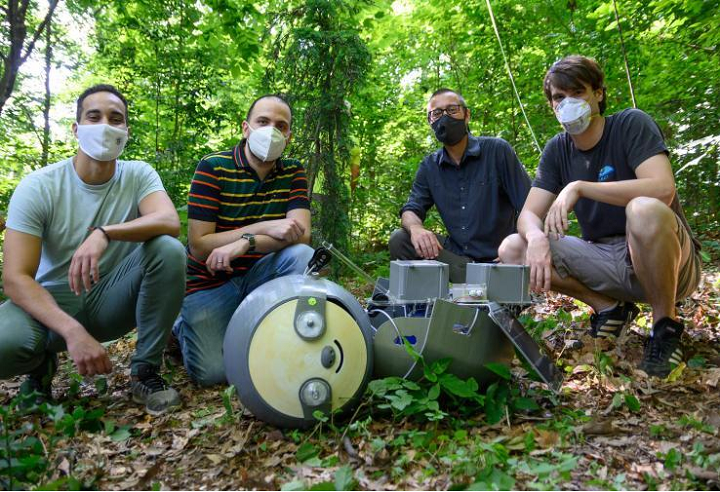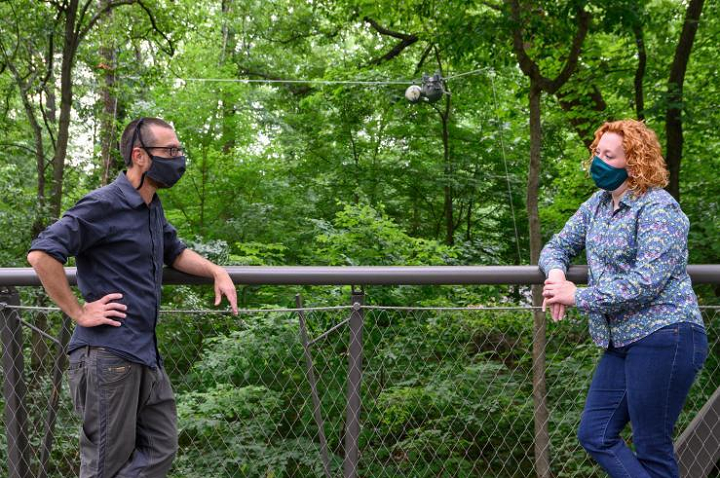A new resident will be living high above the ground in the Atlanta Botanical Garden for the next few months, and while it may resemble an animal, it’s actually a high-tech, energy-efficient device built for wildlife conservation purposes. Its name is SlothBot, and its makers are testing their slow-moving creation in the Garden’s Canopy Walk.
“This will help us tell the story of the merger between technology and conservation. It’s a unique way to engage the public and bring forward a new way to tell our story,” stated Emily Coffey, vice president for conservation and research at the Garden.

Georgia Tech graduate research assistants Yousef Emam and Gennaro Notomista, Professor and School Chair Magnus Egerstedt, and Research Engineer Sean Wilson prepare to install the SlothBot at the Atlanta Botanical Garden.
Developed by a team of robotics engineers at the Georgia Institute of Technology, this adorable robot is meant to be a long-term environmental observer. SlothBot hangs out in the trees, watching the plants, animals, and environmental conditions and moving only when necessary.
“It’s really fascinating to think about robots becoming part of the environment, a member of an ecosystem. While we’re not building an anatomical replica of the living sloth, we believe our robot can be integrated to be part of the ecosystem it’s observing like a real sloth,” said Magnus Egerstedt, professor and Steve W. Chaddick School Chair in the Georgia Tech School of Electrical and Computer Engineering.
Egerstedt got the idea for SlothBot while visiting a vineyard in Costa Rica. He saw toe-toed sloths crawling sluggishly along wires up above, searching for food slowly so as not to expel unnecessary energy.
He said, “It turns out that they were strategically slow, which is what we need if we want to deploy robots for long periods of time. SlothBot embraces slowness as a design principle. That’s not how robots are typically designed today, but being slow and hyper-energy efficient will allow SlothBot to linger in the environment to observe things we can only see by being present continuously for months, or even years.”
In fact, probably the most well-known examples of slow robotic systems are the Mars Exploration Rovers, which spent over 12 years gathering information on the surface of the planet.
“Speed wasn’t really all that important to the Mars Rovers. But they learned a lot during their leisurely exploration of the planet,” Egerstedt said.
The Georgia Tech team first started working on the SlothBot last year, completing a much smaller prototype for the International Conference on Robotics and Automation. The current iteration, supported by the National Science Foundation and the Office of Naval Research, is three feet long.
The robot takes inspiration from its animal namesake, showing how a slower pace can work for some applications. The researchers programmed it to move along a 100-foot cable strung between two trees, using sensors to track data such as carbon dioxide levels, temperature, and weather. It only moves when it needs to, and searches for sunshine in order to recharge its solar-powered batteries. Eventually, the SlothBot will be able to cover more ground by climbing from cable to cable, as a sloth might.
The research team—which also includes postdoctoral researcher Sean Wilson, PhD students Gennaro Notomista and Yousef Emam, and undergraduate student Amy Yao—first considered wheels for the SlothBot, and then flying. But rolling robots can be held up by things like rocks and mud, and too much energy is needed to keep a flying robot in place for long periods of time. For that reason, Egerstedt’s sighting of sloths crawling on wires was a serendipitous one.

SlothBot is a slow-moving, energy-efficient robot that lingers in the trees to monitor animals, plants, and the environment below.
The SlothBot features a 3D-printed shell, with an attached solar panel that powers the motors, gearing, batteries and sensors inside. It’s only the latest example of 3D printing being used to help save endangered species.
“The most exciting goal we’ll demonstrate with SlothBot is the union of robotics and technology with conservation. We do conservation research on imperiled plants and ecosystems around the world, and SlothBot will help us find new and exciting ways to advance our research and conservation goals,” explained Coffey. “SlothBot could do some of our research remotely and help us understand what’s happening with pollinators, interactions between plants and animals, and other phenomena that are difficult to observe otherwise. With the rapid loss of biodiversity and with more than a quarter of the world’s plants potentially heading toward extinction, SlothBot offers us another way to work toward conserving those species.”
The team says that SlothBot can aid them in better understanding the abiotic elements (not derived from living organisms) that impact critical ecosystems, so that animals and the ecosystems themselves can be better protected. But, the low-energy robot could also be used in precision agriculture, relying on its sensors and a camera to measure humidity, watch for insect infestation, and even detect crop diseases early. The SlothBot will hopefully be traveling to South America after Atlanta to observe endangered frogs or orchid pollination.
But before it moves on, the SlothBot could also get Botanical Garden visitors, especially children, more interested in conservation efforts.
“This new way of thinking about robots should trigger curiosity among the kids who will walk by it. Thanks to SlothBot, I’m hoping we will get an entirely new generation interested in what robotics can do to make the world better,” said Egerstedt.
(Sources: New Atlas, Georgia Tech / Images: Rob Felt, Georgia Tech, unless otherwise noted)
Subscribe to Our Email Newsletter
Stay up-to-date on all the latest news from the 3D printing industry and receive information and offers from third party vendors.
Print Services
Upload your 3D Models and get them printed quickly and efficiently.
You May Also Like
Reinventing Reindustrialization: Why NAVWAR Project Manager Spencer Koroly Invented a Made-in-America 3D Printer
It has become virtually impossible to regularly follow additive manufacturing (AM) industry news and not stumble across the term “defense industrial base” (DIB), a concept encompassing all the many diverse...
Inside The Barnes Global Advisors’ Vision for a Stronger AM Ecosystem
As additive manufacturing (AM) continues to revolutionize the industrial landscape, Pittsburgh-based consultancy The Barnes Global Advisors (TBGA) is helping shape what that future looks like. As the largest independent AM...
Ruggedized: How USMC Innovation Officer Matt Pine Navigates 3D Printing in the Military
Disclaimer: Matt Pine’s views are not the views of the Department of Defense nor the U.S. Marine Corps Throughout this decade thus far, the military’s adoption of additive manufacturing (AM)...
U.S. Congress Calls Out 3D Printing in Proposal for Commercial Reserve Manufacturing Network
Last week, the U.S. House of Representatives’ Appropriations Committee moved the FY 2026 defense bill forward to the House floor. Included in the legislation is a $131 million proposal for...





































